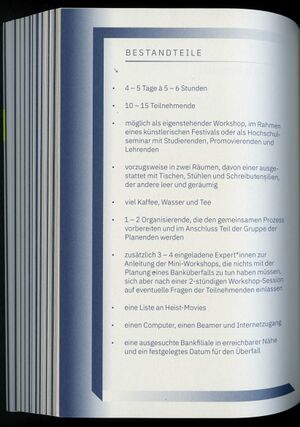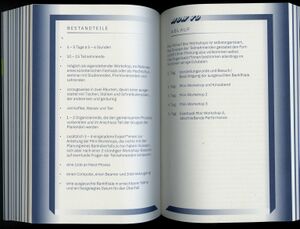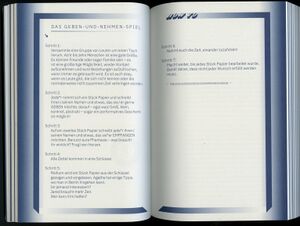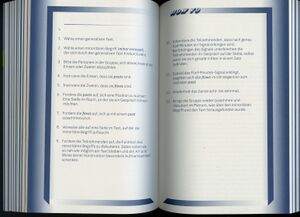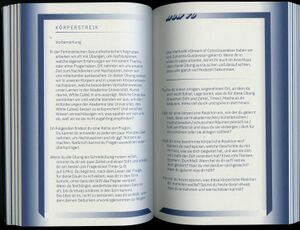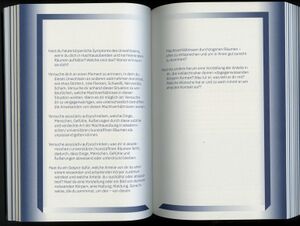Learning to Experiment, Sharing Techniques
“[S]tudy is what you do with other people. It’s talking and walking around with other people, working, dancing, suffering, some irreducible convergence of all three, held under the name of speculative practice. The notion of a rehearsal – being in a kind of workshop, playing in a band, in a jam session, or old men sitting on a porch, or people working together in a factory – there are these various modes of activity.”[1]
“To study” is an activity—it combines teaching and learning, two activities that are usually considered separate. In the book The Undercommons. Fugitive Planning and Black Study, Stefano Harney and Fred Moten set out to distinguish the collective activity of study from the study that takes place within educational and academic institutions. They point out that collective study happens while playing, making music, biking, discussing with friends, traveling. While teaching and learning in Western societies is deemed to take place within educational institutions, and is structured by evaluation systems, assessments, and grades, Harney and Moten show that study is by no means limited to these spaces. They argue that most study happens beyond institutional settings. Study is collective, sometimes you are a learner and sometimes a teacher, but often you are both. Teaching and learning do not just happen, they are not only emergent events, they are made possible through a series of techniques. Sometimes these techniques are visible, while often they go unnoticed. These techniques—rather than the institutions with which they are associated—are what we are interested in.
nocturne: A platform for teaching and learning
Often, we meet scholars, artists, and activists who have developed ideas and pedagogical techniques in their personal practices and in dialogue with their students and workshop participants. In order to share these techniques beyond their initial contexts—classroom, studio, workshops—we initiated nocturne,[2] a platform for experimental knowledge production across art, academia, and activism. It is a platform that grew from our curiosity and enthusiasm for the many experimental pedagogical formats that exist outside of dominant institutional settings. It brings together a series of techniques for experimental teaching sourced across the fields of art, performance, philosophy, theater, film, and media studies. Each contribution consists of a technique that was developed during seminars and workshops, and in studios and rehearsal spaces. The contributions include: a collaborative fabulation of a bank robbery; the now familiar format of the reading group; writing workshops; collage; film essays; and a group performance. The platform is intended to offer an insight into the field of experimental and collaborative pedagogy. It is understood as open-source in the sense that it is an invitation to try, adapt, and further develop the techniques in other contexts. In this respect, by collecting and documenting the techniques, we are contributing to the continued circulation of knowledge that extends beyond institutional boundaries.
We focus primarily on techniques that use artistic practices not only as illustrations of theories, but that take them seriously as practical ways of thinking. As such, the techniques are connected to academic education and political activism. We are interested in the diversity of techniques and procedures at work in artistic practices and the processual knowledge they produce. These techniques include playing, dancing, creating space, montaging, collaging, writing, etc. Through reading groups, teach-ins, or collective fabulations,[3] they question the hierarchical order between production and reproduction, practice and theory, n research and teaching.
Through our engagement with experimental pedagogies, we build upon a long history of activity including that of Black Mountain College; the Feminist Studio Workshop; the work of artists such as Lygia Clark, Miklós Erdély, and Dóra Maurer; and educators such as Paulo Freire, bell hooks, and Leanne Betasamosake Simpson. Recent initiatives include the Performing Arts Forum in St. Erme and the SenseLab in Montréal. Most examples practice(d) outside of established institutions, while others are part of existing curriculums for art and design.[4] These foundations are echoed in the techniques explored in nocturne. Some techniques, like the contributions by Erin Manning and Brian Massumi, were developed in the context of one of the projects, while others, like Juli Reinartz’ or Inga Zimprichs engaged with this history more indirectly.
How-To…
In our first publication Learning to Experiment, Sharing Techniques: A Speculative Handbook[5] we adopt the format of a “how-to” style manual to “document” the techniques included. By mimicking the how-to of a handbook we emphasize the pragmatic approach to every technique. It is a book to use. And yet its pragmatism does not equate with a goal-oriented approach. In fact, for us, pragmatism is a form of engagement that is attuned to an actual situation but not limited to it. To avoid pragmatism becoming a means to an end, we emphasize its speculative dimension. It may seem paradoxical at first to use speculation and pragmatism simultaneously. But the logic of speculative pragmatism[6] allows us to think of techniques not as something one needs to earn or learn to master, but rather as a way to put into practice speculatively in the midst of an actual situation. Speculative how-tos, as we propose them, are open to appropriation. They are, in Brian Massumi’s words, “enabling constraints.”[7]
A technique that straddles the line between pragmatism and speculation in a performative way is The Perfect Robbery by Juli Reinartz. The task is simple: plan to rob a bank. While time and location situate the technique in the here and now, the task immediately opens up a space for collective planning fueled by the speculative energy of criminal conspiracy, making it speculative in its radical sense. It is a technique of future problem-solving rather than free-floating imagination. This combination of pragmatism and speculation is shared by many of the techniques included on nocturne. They are pragmatic because they orient an action or a collective toward processes embedded in the here and now. They are speculative because they transform this process, feeding it into new situations, and thereby changing the collective as much as the situation itself.
Pragmatic Experimentation
The techniques gathered at nocturne are not simply practice-based, but pragmatic in their philosophical sense. They take experience seriously as a starting point from which to work with theoretical concepts.[8] Rather than just applying thinking to experience or experience to thinking, the relation between the two realms—theory and practice, thinking and experiencing—grounds every practice. This logic of co-composition shifts teaching from an act of mediating learning content, to a form of experimentation in which content and techniques are in constant dialogue and constantly rearranged, making the very distinctions between theory and practice, and concept and experience, even harder to maintain. When we think of pedagogical techniques and the activity of teaching, we do not limit it to the explanation of existing knowledge, but think of them as situations joint together by learning and experimentation, from which topics and techniques emerge and are experimented with. We consider learning in a broad and embodied sense, focusing on the art of creating situations from which something new can emerge. This is why we turn to those spaces where art, activism, and pedagogy are intertwined.
Through her work as a teacher, bell hooks has shown us how the personal experiences of teachers and learners—inside and outside of the classroom—are key for pedagogical processes. These experiences are social and saturated by power structures. It is these power structures that must become the starting point of a political and critical reflection on education.
The questioning of existing structures generates new access to knowledge spaces, especially for those who are formally or informally excluded due to their background and biography.[9] Therefore, nocturne places artistic research in dialogue with classical examples of social emancipation in the fields of media, art, and cultural studies. The aim of artistic pedagogies is not the promotion of creativity as an end in itself, but the activation of emancipative and reflexive processes on the level of perception and bodily activity.
bell hooks, writing from an African-American working-class perspective, sees her teaching practice as a professor and lecturer at a university as an activity of change, liberation, and empowerment. In Teaching to Transgress,[10] the first title of her trilogy on teaching, hooks describes her encounters with those who resisted the different and radical forms of pedagogy she tried to put into practice. According to hooks, freedom and transgression can by no means be achieved by simply negating outmoded pedagogies. New techniques and new pedagogical concepts are needed to empower precisely those students (African-Americans, immigrants, women*, first-generation academics) who are all too often overlooked in existing structures. For hooks, teaching can form a technique of transformation and collectivity, “The power of the liberatory classroom is in fact the power of the learning process, the work we do to establish a community.”[11] Affects such as “excitement” and “fun”[12] are prerequisites for learning and teaching. She calls for pedagogical techniques that focus less on teaching and more on the “atmosphere” of learning itself.[13] This shows how affect is not incidental, but in fact determines how habitus makes one move subconsciously away from or toward certain learning situations.[14] We think of terms like “excitement” as affective spaces of possibility and ways in which bodies affect other bodies and can themselves be affected.[15]
Learning outside of the University
In recent years, non-academic learning formats have gained traction. They connect to the radical pedagogies of the 1970s and 1980s, to feminist and Black reading circles, to empowerment and consciousness raising, and to decolonial struggles in the Americas. They reference the pedagogical and therapeutic reforms of Fernand Oury and Aïda Vasques (1969), Paulo Freire (2018), bell hooks (1994), Félix Guattari (2015), and Fernand Deligny (2013). Movements influenced by these thinkers, teachers, artists, and political activists, have invented ways of learning that aim to make social, individual, and institutional transformation and change.
Next to critical developments in pedagogy, artists of the 20th century engaged repeatedly in new and different forms of teaching and learning. For example, Alan Kaprow explored playful pedagogies in his happenings, extending activities of teaching and learning into the realm of art and feeding artistic techniques into the curriculum of schools and universities.[16] Or, in a similar manner, composer, musician, and university professor George E. Lewis, in Collaborative Improvisation as Critical Pedagogy,[17] describes his artistic practice of jazz as an act of collective mediation in experimental improvisation, “In this view, improvisation becomes a critical practice as well as a means to aesthetic statement - a space where discontinuity, disruption, support, and struggle become audible pathways to new experience.”[18] Both of them[19] tie in with the theories of pragmatism mentioned above. Their artistic engagements placed experience at the very heart of learning. Rather than the teaching serving as a way to bestow knowledge upon students, the impact of the material learning environment became the focus of their pedagogies.
Today, at film or theater festivals, museums and galleries, both formal and informal learning takes place. Silent University, School of Commons, Training for the Future, and Black Market for Useful Knowledge and Non-Knowledge are just a few of the many frameworks in which alternative modes of learning are being organized. In Black Market, Hannah Hurzig for example assembles teachers and learners who, in precisely-timed sessions, share, and produce knowledge through one-to-one conversations. The people she invites are experts in many regards. Hurzig is explicitly concerned with creating informal structures in which a broad spectrum of knowledge is negotiated with and circulated.
While many of these projects share references to educational intuitions by referring to themselves as schools or universities, others, like the Social Muscle Club, emphasize the collective aspect of their work, while still being places of learning and sharing. Centered on a game-like structure of give andA technique that straddles the line bet take, the Social Muscle Club developed a technique to create social relations. Its engagement with learning and training forms of collectivity makes it a key contribution to the techniques of alternative and experimental forms of pedagogy.
Most aforementioned projects resort to the workshop as a format to facilitate their pedagogical and collective engagements. The workshop—be it a collective movement session, a hackathon, or a reading group—has developed out of the need to question the institution of the university. Especially nowadays, in times of increasingly modularized university education, workshops offer a way to collectively learn outside of established institutions.[20] These new sites and formats of “other knowledge”[21] often combine political intervention and collective organization. Many workshops establish situations that are open, while creating techniques that others can use in new and different contexts.
Technique and Institution
On March 24, 1965, teachers and students across the U.S. left their scheduled seminars to spend the entire night in so-called “teach-ins,” debating U.S. policy on the Vietnam War. It was an act of public protest but more so—as Marshal Sahlins, one of the teachers involved noted—this inter-university, nationwide debate on the Vietnam War and U.S. Cold War politics produced “a genuine intellectual experience.” Sahlins elaborates, “for many the first they ever had on campus, perhaps because for the first time both teachers and students were discussing, seriously and with respect for each other’s opinions, something both were deeply interested in understanding.”[22] This example shows that it is impossible for the university (the school, the museum, etc.) to capture the powerful act of teaching. In fact, Sahlins’ quote shows that, when teaching leaves the institution, it becomes an “intellectual experience” and a truly collective practice. Teach-ins opened up a space for other and new pedagogical techniques to emerge, techniques that were academic as much as activist. The simple shift of time and location produced other knowledges as much as collectivity.
As this example shows, techniques are more than an institutional intervention. As much as we find techniques at work in institutions they can also challenge and work against existing and emerging institutions. Techniques can transform power relations as well as ingrained patterns of acting and thinking. Techniques can render background structures conscious[23] and create communities that oppose the processes of institutionalization and/or neoliberalization in the spirit of “lifelong learning.” Techniques are neither good or bad; institutional or revolutionary. They can always be hacked and used in different ways. It is, to use Alfred North Whitehead’s phrase, a question of “style,”[24] how a technique is used determines its effects and impacts. In this sense, the style of experimentation can help to keep techniques in a process of continuous transformation. Changing and combining them with other techniques prevents their sedimentation into a rule or even law. It is sometimes necessary to continue a discussion beyond the timeframe of the seminar, for instance to allow an extensive debate on foreign policy, as in the case of the teach-ins.
Create access!
Teach-ins, workshops, and informal reading groups are modes of organizing learning beyond institutional frameworks, especially in countries with extremely high educational costs. Many of them aim to facilitate learning differently than universities—decolonized, democratized, and organized in solidary ways.[25] They create new collectives of thought, experience, and imagination. But even the simple act of reading together can lead to the exclusion of others and create hierarchies among its participants. Especially in collectives working across art, academia, and activism, the use of language and the distribution of who speaks when and for how long can institute and reinforce social power relations. How, then, can we create techniques that challenge these structures? How to invent formats that do not privilege certain (often academic) knowledge, but fosters the exchange between different forms and practices of knowledge?
Sometimes a small shift in the spatial setting or a playful formalization of who talks and when can create an entirely different dynamic. Conceptual speed dating, a technique stemming from the practice of the SenseLab and shared by Brian Massumi is one such attempt. Organizing a text discussion in a flow of multiple short conversations decentralizes discussions, de-personalizes arguments, and creates new modes of collective thinking.
While such techniques to increase access often stem from contexts outside of educational institutions they can be important contributions to the techniques of schools and universities. Even in countries without tuition fees, the informal ways access is blocked to the university or to an academic career are numerous. Pierre Bourdieu has described these unconscious forms as exclusions and self-exclusions with his concept of habitus.[26] Didier Eribon, in Returning to Reims,[27] explored these thresholds through his own experience and made vivid how complex exclusions function in the educational system.
Every pedagogical relation and every technique must therefore ask how it addresses exclusions based on gender, race, class, and dis_ability. The techniques assembled on the platform, nocturne, aim to counter subconscious exclusions and increase access on multiple levels. When sharing these techniques between the artistic, academic, and activist field, the question of access makes it important not to simply reproduce techniques in different settings. What creates access in one situation can be exclusionary in another one. Every technique needs to be tried out and developed in context-sensitive ways.
Make situations!
We founded nocturne with an enthusiasm for learning and unlearning as critical and emancipative educational processes. In this context, we understand pedagogy primarily as a way of working with techniques to produce collective situations i.e., less autodidactic or individualistic learning. Here, we have primarily social and ecological processes in mind. Learning also means the experience of becoming different. This means not to be re-educated, but to create and encounter every new learning situation openly.
In emancipatory teaching, chaos is used in a productive way. Deleuze and Guattari[28] describe this by proposing their concept of the refrain: Learning is a chaosmos, a “rhythm”[29] between chaos and its frame. This refrain causes a transformation of knowledge as much as its transforms the self of all participants, teachers, and learners. In a situation where learning takes place, the self is not individualized, it “transindividuates.”[30] To think of learning as an act of trans/individuation affirms a way of thinking through the situation and the milieu/media it creates.[31] Trans/individuation happens through the techniques of learning, teaching, and designing.
In institutionalized higher education, pedagogy and didactics (as helpful as they can be in some cases) are often subordinated to questions of efficiency. We are urged to complete trainings in didactics to use our pedagogical methods purposefully, to give proper feedback, and to learn how to grade. While it is important to reflect on our power positions in educational contexts, we are rarely taught in these trainings about the activist teaching techniques of Black writers, workers struggle at the university, liberation pedagogies of the Americas, or the ways second-wave feminism organized learning and unlearning. With nocturne, we want to build on these traditions.
How to engage critically with the knowledge and affects produced by the university and other institutions is at the heart of the technique Bodystrike by the Feminist Health Care Research Group. Situated in the feminist tradition of self-organized health care, the technique offers way to work with the bodily and affective knowledge often sidelined in institutionalized processes of education.
Change the logistical university!
The logistical university is, as Moten and Harney put it, a university of debt: Debt through student loans and debt through credits to be earned.[32] What the students get for their debt is skill. Instead of facts, the university teaches skills that can be used elsewhere, and skills that travel and make the students travel through the market economy. This flow of skills renders the university and its students logistical. If we go back a few years, skills training did not begin as a logistical fantasy but as a critique of the accumulation of facts (as described by Paulo Freire in his “banking model“[33] method) and came with the promise of increased freedom. In recent decades, this development turned into a total obliviousness of knowledge only striving towards the teaching of skills to be applied in every situation at all times. If everything is transferable and applicable, any reference to the history, situation, and emancipatory politics of a technique is lost. When we engage in technique-sharing, we are not interested cookie-cutter applications that don’t engage with the situations from which the technique originates. We call for techniques that enable collectivity, solidarity, and openness. Elke Bippus and Monica Gaspar point out that the shift from content to competence (and thus to technique) can also bear the danger of feeding experimental ways of working known from art into all realms of economic production and education. Through collaborations between academia and the arts, precarization of both fields occurs, and this is highly based on self-exploitation. Creative techniques of the arts are fed into the field of capitalist labor, rehearsing its experimental character and accelerating precarious working conditions, which renders the arts as much as labor logistical.[34] Yet a critique of neoliberalism should not be conflated with a critique of creativity and experimentation as such. We need to address the critical qualities inherent in experimental techniques. In view of this development as well as the increasing institutionalization of artistic research in the sense of its scientification, we want to ask how techniques can produce solidary and critical forms of collective working. How can we rethink creative collaboration starting from the techniques at work in a situation? How can we foster speculative practices, which go beyond use of goal-oriented techniques? We hope that the exchange of techniques of learning and unlearning can lead to a revaluation of the concept of technique in a non-utilitarian manner. Techniques de-essentialize learning and knowledge through the focus on their processual and situated nature. Sharing these techniques must include engagement with the situations from which they originated. Like Everybody’s Toolbox[35] proposes for the field of performance and dance, we think of techniques and instructions as open-source. They are open to hacking, modification, and speculative adaptation. Each technique Hon the platform is an invitation to its reader to document their own experiences, and share the techniques they work with.
Bibliography
- Bee, Julia and Gerko Egert (ed.). Experimente lernen, Techniken tauschen. Ein spekulatives Handlbuch. Weimar/Berlin: Nocturne, 2020.
- Bippus, Elke/Gaspar, Monica.”Forschendes Lernen in der Kunst,“ in: Forschendes Lernen. Wie die Lehre in Universität und Fachhochschule erneuert werden kann, 260-368. Frankfurt and New York: Campus, 2017.
- Bourdieu, Pierre. The Inheritors: French Students and Their Relation to Culture. Chicago: University of Chicago Press 1979.
- Bourdieu, Pierre. The Logic of Practice. Stanford (CA): Stanford University Press, 1990.
- Bourdieu, Pierre. Homo Academicus. Cambridge: Polity Press, 1990.
- Bourdieu, Pierre. The State Nobility: Elite Schools in the Field of Power. Cambridge: Polity Press, 1996.
- Busch, Kathrin (Ed.). Anderes Wissen. Kunstformen der Theorie. Paderborn: Fink, 2016.
- Combes, Muriel. Gilbert Simondon and the Philosophy of the Transindividual. Cambridge (Ma) and London: MIT Press, 2013.
- Deleuze, Gilles.. Logic of Sense. New York: Columbia University Press, 1990.
- Deleuze, Gilles. “Mediators,” in Negotiations, 1972-1990, 121-134. New York: Columbia University Press, 1995.
- Deleuze, Gilles, and Félix Guattari. A Thousand Plateaus: Capitalism and Schizophrenia. Minneapolis: University of Minnesota Press, 1987.
- Deleuze, Gilles, and Félix Guattari. What Is Philosophy? New York: Columbia University Press, 1994.
- Deligny, Fernand. Cartes et lignes d’erre/Maps and wander lines: Traces du réseau de Fernand Deligny 1969 - 1979. Paris: L’Arachnéen, 2013.
- Dewey, John. Experience and Education. New York: Free Press, 2015.
- Egert, Gerko et al. Radical Pedagogies. Inflexions. A Journal for Research Creation, No. 8 (2015):http://inflexions.org/radicalpedagogy/main.html.
- Eribon, Didier. Returning to Reims. Los Angeles CA: Semiotext(e), 2013.
- Freire, Paulo. Pedagogy of the Oppressed. New York: Bloomsbury, 2018.
- Groten, Anja. “Workshop,” in Making Matters, ed. Janneke Wesseling, Florian Cramer Amsterdam: Valiz, 2022.
- Guattari, Félix. Psychoanalysis and Transversality. Texts and Interviews 1955-1971. South Pasadena: Semiotext(e), 2015.
- Harney, Stefano, and Fred Moten. The Undercommons. Fugitive Planning and Black Study. Wivenhoe u.a.: Minor Compositions, 2013.
- hooks, bell. Teaching to Transgress. Education as the Practice to Freedom. London and New York: Routledge, 1994.
- James, William. Essays in Radical Empiricism. Lincoln: University of Nebraska Press, 1996.
- Jaschke, Beatrice, Sternfeld, Nora, and Schnittpunkte (Ed.) (2012): Educational Turn. Handlungsräume der Kunst, Wien and Berlin: Turia & Kant.
- Kunst, Bojana. Artist at Work, Proximity of Art and Capitalism. Winchester: Zero, 2015.
- Krstich, Vesna. “The Pedagogy of Play: Fluxus, Happenings, and Curriculum Reform in the 1960s,” in C Magazin 131 (2015): 14–18.
- Lewis, G. E., “Collaborative Improvisation as Critical Pedagogy.” Nka Journal of Contemporary African Art 34, (2014): 40–47.
- Manning, Erin, and Brian Massumi. Thought in the Act: Passages in the Ecology of Experience. Minneapolis: University of Minnesota Press, 2014.
- Massumi, Brian, and Joel MacKim. “Of Microperceptions and Micropolitics. An Interview with Brian Massumi,” in Inflexions. A Journal for Research-Creation, 3 (2009):: http://www.inflexions.org/n3_massumihtml.html.
- Paim, Nina, Corinne Gisel, and Emilia Bergmark (Ed.). Taking a Line for a Walk. Assignments in Design Education. Leipzig: Spector Books, 2019.
- Sahlins, Marshall. Culture as Practice. Selected Essays. New York: Zone, 2000..
- Sarachild, Kathie, “Consciousness-Raising: A Radical Weapon.” in Feminist Revolution, ed. by Redstockings, 144–50. New York: Random House, 1978.
- Simondon Gilbert. Individuation in Light of Notions of Form and Information. Minneapolis: University of Minnesota Press, 2020.
- Smith, Linda Tuhiwai. Decolonizing Methodologies: Research and Indigenous Peoples. St Martin’s Press, 1999.
- Spinoza Benedictus de. Ethics: Proved in Geometrical Order. Cambridge: Cambridge University Press, 2018.
- Stengers, Isabelle. “Introductory Notes on an Ecology of Practices.” Cultural Studies Review 11, 1 (2005): 183–96.
- Vasquez, Aïda, and Fernand Oury (1969). “The Educational Technique of Freinet.” Prospects in Education 1: 43–51.
- Whitehead, Alfred North. The Aims of Education and other Essays. New York: Free Press, 1967.
